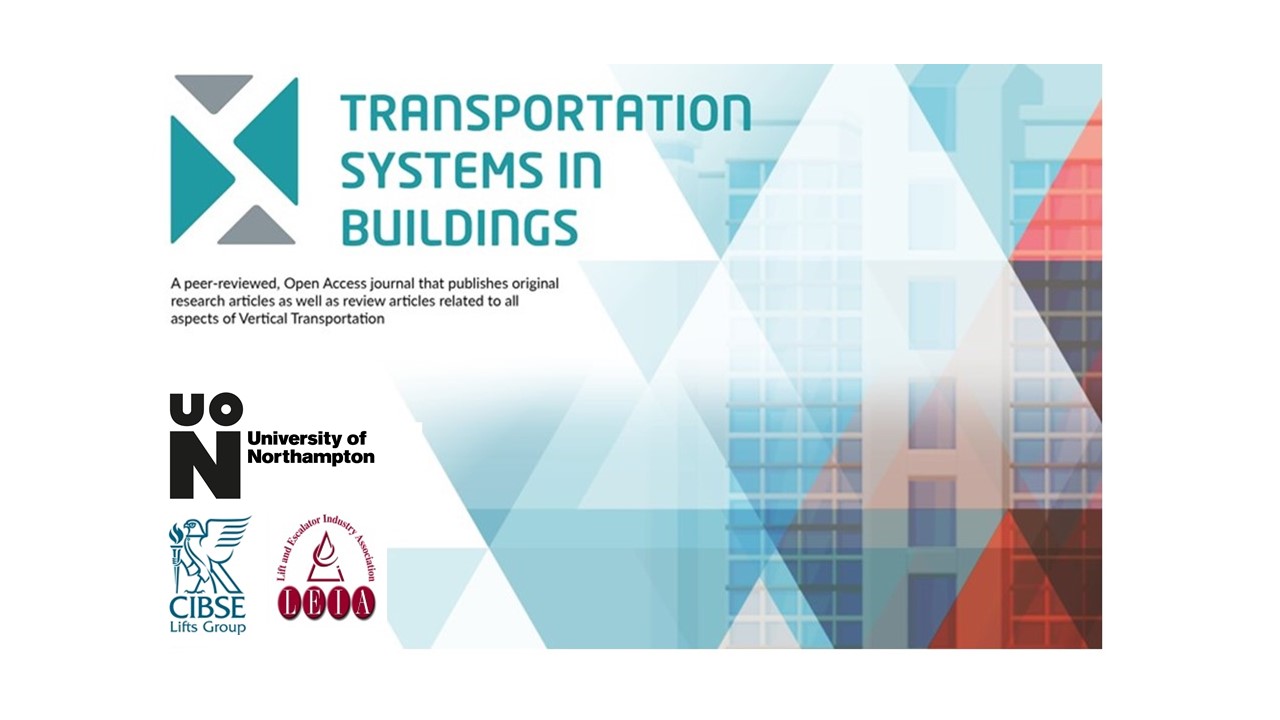Circulating multi car lift system – traffic concept and analysis
DOI:
https://doi.org/10.14234/tsib.v1i1.107Abstract
A new generation of lifts currently under development applies magnetic linear propulsion and does not need ropes. Shafts are shared, and lifts move in two or more dimensions. Taller and more densely populated buildings will be accommodated by adding more cars but not necessarily more shafts. Engineers planning lift installations need new ways to assess the handling capacity and quality of service provided by ropeless lifts. In this paper possible traffic concepts are considered as well as some traffic design principles being established by applying simple cycle time calculations. For example, shuttle lift applications are considered and compared with current roped solutions. Improving on cycle time calculations requires the development of dispatching strategies, the modelling of safety distance requirements and traffic simulation models; an overview of progress in these areas will be presented.References
Thumm, G. (2004) A breakthrough in lift handling capacity. In: Elevator Technology 14, Proceedings of Elevcon 2004. The International Association of Elevator Engineers.
Elevator World (2015) The elevator museum - timeline [online]. Available from: http://www.theelevatormuseum.org/timeline.php [Accessed 05/11, 2015].
Strakosch, G. and Caporale, R. (2010) The Vertical Transportation Handbook, Fourth Edition. Hoboken; New Jersey: John Wiley & Sons, Inc.
https://doi.org/10.1002/9780470949818
Elevator World, (1996) An elevator go round. Elevator World, (January), pp. 42
Jappsen, H. (2002) High Rise Elevators For The 21st Century. In: Elevator Technology 12, Proceedings of Elevcon 2002. The International Association of Elevator Engineers.
Godwin, A. (2010) Circular transportation in the 21st century (without the 'beautiful' counterweight!). In: Elevator Technology 18, Proceedings of Elevcon 2010. The International Association of Elevator Engineers.
So, A., Al-Sharif, L. and Hammoudeh, A. (2014) Analysis of Possible Two Dimensional Elevator Traffic Systems in Large Buildings. In: Elevator Technology 20, Proceedings of Elevcon 2014. The International Association of Elevator Engineers.
So, A., Al-Sharif, L. and Hammoudeh, A. (2015) Traffic analysis of a simplified two-dimensional elevator system. Building Services Engineering Research and Technology.
https://doi.org/10.1177/0143624414568728
ThyssenKrupp Elevator AG (2014) New era of elevators to revolutionize high-rise and mid-rise construction [online]. Available from: http://www.urban-hub.com/ideas/new-era-of-elevators-to-revolutionize-high-rise-and-mid-rise-construction/ [Accessed 04/20, 2015].
Jetter, M. and Gerstenmeyer, S. (2015) A Next Generation Vertical Transportation System. In: Wood, A. & Gabel, J. (eds.), The Future of Tall: A Selection of Written Works on Current Skyscraper Innovations. Addendum to the Proceedings of the CTBUH 2015 International Conference, New York, 26–30 October 2015. Chicago: Council on Tall Buildings and Urban Habitat.
Smith, A. (2016) Engineers cut lose as ropeless lifts enter space race [online]. Available from: http://www.cibsejournal.com/technical/engineers-cut-lose-as-ropeless-lifts-enter-space-race/ [Accessed 01/08, 2016].
Scott, A. (2016) Are we ready for the ropeless lift?[online]. Available from: http://www.cibsejournal.com/technical/engineers-cut-lose-as-ropeless-lifts-enter-space-race/ [Accessed 01/08, 2016].
Kaczmarczyk, S. (2008) The dynamic response of elevator compensating ropes in high-rise buildings. In: Elevator Technology 17. The International Association of Elevator Engineers.
CIBSE (2010) CIBSE Guide D: 2010 Transportation Systems in Buildings. London: The Chartered Institution of Building Services Engineers.
Müller, J. (2014) Lift Systems in High-Rise Buildings: Handling Capacity and Energy Efficiency. In: Symposium on Lift and Escalator Technologies. Northampton:
Siikonen, M. (1997) Planning and Control Models for Elevators in High-Rise Buildings. Research Reports A68. Helsinki University of Technology, Systems Analysis Laboratory.
Gerstenmeyer, S. and Peters, R. (2015) Safety distance control for multi car lifts. Research paper, draft, unpublished.
Smith, R. and Gerstenmeyer, S. (2013) A review of Waiting Time, Journey Time and Quality of Service. In: Symposium on Lift and Escalator Technologies. Northampton:
Peters, R. (2013) The Application of Simulation to Traffic Design and Dispatcher Testing. In: Symposium on Lift and Escalator Technologies. Northampton:
Gerstenmeyer, S. and Peters, R. (2015) Lifts without ropes: how many shafts and cars are needed? In: Symposium on Lift and Escalator Technologies. Northampton
Downloads
Published
How to Cite
Issue
Section
License
The author(s) must warrant that an article is original and the sole work of the author(s); the author(s) must also obtain relevant permissions from any third-party copyright holders. Where an article or report has more than one author, the submitting author is responsible for ensuring that all other authors agree to the terms of submission.
Copyright and associated moral rights in works published in Transportation Systems in Buildings are retained by the authors. Authors grant to The University of Northampton and Transportation Systems in Buildings non-exclusive rights to reproduce works electronically (in full or in part) and to publish works in any such media current or later developed. By virtue of their appearance in this open access journal, works may be used freely, with proper attribution, in educational and other non-commercial settings.

